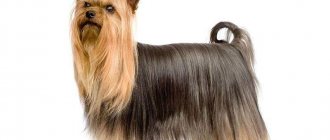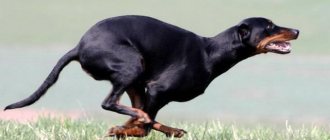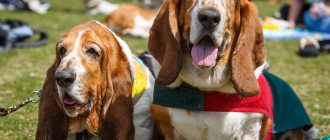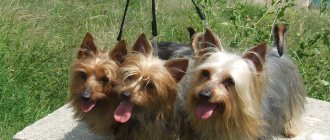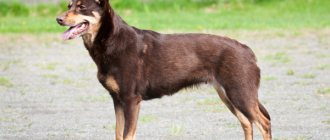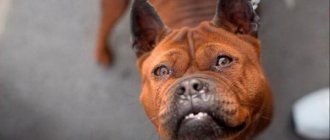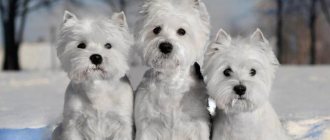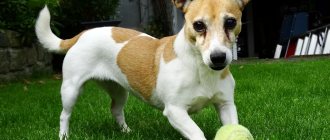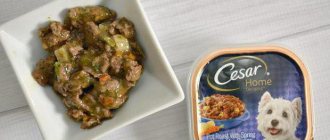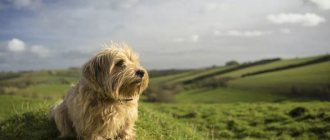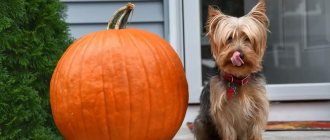The Australian Terrier is a little-known breed bred in Australia for hunting and guarding. She has an unremarkable appearance, but a kind and cheerful disposition. Thanks to these character traits, compact size and unpretentiousness, the dogs have become famous all over the world. However, such a pet is not suitable for everyone. After all, the dog needs regular physical and mental exercise, and only a person with leadership qualities can earn his favor. Let's figure out what other features of this breed its future owner should know about.
Brief history of origin
The breed was bred in Australia to work in difficult terrain. Dogs were supposed to exterminate rats and snakes, hunt burrowing animals, and guard houses and garden plots.
The ancestors of this breed were wire-haired terriers that lived in several states of Australia:
- Tasmania;
- New South Wales;
- Victoria.
The animals were crossed with British breeds: Scotch Terriers, Skye Terriers and Dandie Dinmont Terriers. Occasionally, the blood of Yorkshire terriers rushed.
Australian terriers were first mentioned in 1820 in the Kennel Control Council of Victoria. In 1872 they were presented at an exhibition in Melbourne as a “wire-haired terrier of black and blue color”, and 24 years later breeders developed an official standard.
Gradually the breed spread throughout Europe and came to the USA. The English Kennel Club registered Australian Terriers in 1933, and the FCI registered them in 1962.
Interesting Facts
There are some interesting facts associated with Australian terriers:
- The Australian Terrier is the first of all breeds bred in Australia to be officially recognized not only in its homeland, but throughout the world.
- Until 1929, Australian, Yorkshire and Australian Silk Terriers were not considered different breeds.
- An Australian terrier named Vicky starred in Eduard Radzyukevich’s film “Allinclusive, or All Inclusive.”
Training
Silkie Terriers react very poorly to irritation and physical aggression towards them. This can ruin all your attempts to teach your pet something. The best training method here is affection and a caring attitude.
This breed is very smart, but quite stubborn. Therefore, it will take some time to teach her some commands. But if you teach a dog from an early age to walk in crowded places, the socialization process will go faster, and mutual understanding will be established between the owner and the animal.
Breed description, standards and appearance
The Australian Terrier is a compact, stocky, elongated dog. This is one of the smallest representatives of the breed group, with working qualities:
- height – about 25 cm;
- weight – approximately 6.5 kg.
Animals exhibit sexual dimorphism - girls are always slightly shorter and lighter than boys.
Characteristics of the breed according to the ICF standard No. 8:
- The skull is elongated and smooth, quite wide between the ears. Covered with a characteristic forelock. The stop is small but noticeable.
- The muzzle is strong and robust, providing a powerful grip. Its length is equal to the distance from the stop to the occipital protuberance.
- The lobe is medium, always painted black.
- Thick, dry lips conceal powerful jaws set in a scissor bite.
- The eyes of representatives of the breed are small and oval. Set quite wide. The pigmentation of the iris is dark brown. The look is insightful and energetic.
- The ears are small, with pointed tips, very mobile and sensitive. They stand up fully by six months.
- The neck is moderately long, slightly arched. Blends harmoniously into strong shoulders.
- The body is elongated, strong and squat, with a straight back and strong loin.
- The chest is quite wide and deep. The front part is very well developed.
- The tail is most often docked. But in any case, it should sit high and be carried vertically. Throwing onto the back is unacceptable.
- The limbs are strong, even and parallel. The paws are compact, pointing straight forward, the toes are gathered into a ball.
The Australian Terrier moves easily and springily, without a hint of weakness. The limbs move parallel to each other.
The hind legs give a powerful impulse to the whole body.
Important. Aggressive and cowardly dogs, as well as representatives of the breed with physical or behavioral abnormalities, are disqualified.
Color and coat type
Representatives of the breed have a two-layer coat:
- hard spine approximately 6 cm long;
- short and soft undercoat.
There are no long hairs on the face and legs below the metacarpus and shins.
Permitted colors of the breed:
- Blue, steel, dark gray with bright brown markings on the head, lower body and around the genitals. The transition from one color to another should have clear boundaries. Too light or blackened tan is not welcome. The forelock can be blue, silver or slightly lighter than the main tone.
- Fawn or red without dark areas. A lighter forelock is also acceptable.
The score will be reduced if the dog has white spots on the chest or legs.
Distinctive features
Since the breed was bred as a hunter of small rodents, the size of its representatives is small: 20-26 cm
in height at the withers . The standard is not divided into female and male, but females are usually smaller. Dogs weigh from 5 to 7 kg .
They are easy to care for and live comfortably in an apartment. There are standards by which the thoroughbred and purebred of a puppy are determined:
- The head is wedge-shaped, medium in size, proportional to the body. The skull is strong with a flattened forehead and a rounded occipital region. The muzzle is of medium length, tapering towards the nose. The transition from the forehead is moderately expressed. The jaws are strong, have a scissor bite, and the teeth are straight.
- The lips are thin and do not sag.
- The eyes are small, not set wide, and not bulging. The shape is round, the iris is in dark shades of brown. The eyelids are pigmented black. The look is attentive and intelligent.
- The nose is medium with open nostrils. Only black is considered the correct color.
- The ears are erect and it is not customary to crop them. V-shaped: the base is wide, the tip is narrowed (sharp or rounded). Cartilage tissue is thin and mobile.
- The body is low, elongated, but proportional to the height. The back is straight and does not transform during movements. The loin is narrow but strong; the thoracic region is expanded. The neck is short, wide, flowing into the back with a smooth curve, there is no dewlap.
- The tail is set high and vertical. It is customary to cut to medium length. The hair on the tail is short, without a tassel. If the tail is not docked, the shape is crescent-shaped without a loop.
- The limbs are shortened and strong. The hind ones are slightly longer than the front ones. The feet are round and small with hard dark claws.
- The coat is dense, harsh, and of medium length. It forms a mane on the neck and around the head. As a rule, dogs are not trimmed.
- The color can be of several types: steel, blue, red, sand. Puppies are born with black fur.
For any deviations from these standards, the dog may be considered defective and excommunicated from further participation in the reproduction of individuals.
Character and behavior
The Australian Terrier is a hardy and courageous dog, hardened by harsh living conditions. Representatives of the breed have excellent instincts and lightning-fast reactions. The developed guard instinct turns them into good guards.
Australian Terriers have a cheerful, friendly, cheerful character and temperament. They are obedient, balanced and very devoted to their owner, which makes pets excellent companions.
Australian Terriers are not recommended to be kept with other pets. They consider all small animals to be hunted. On walks, clashes with other dogs are possible, since many representatives of the breed are quite pugnacious.
Expert opinion
Leonid Rodin
Experienced dog breeder
Ask a Question
Like all other dogs of this line, the Australian Terrier is tireless, energetic, has a strong hunting instinct and does not need excessive care from the owner. He is not very suitable for keeping at home, especially for living in families with children. The fact is that the breed ambitions of the Australian Terrier force him to constantly strive to gain leadership. He recognizes the owner as the “leader of the pack,” but as for the other members of the household, they will always remain at the lower hierarchical levels. And in this situation, children find themselves in the most defenseless state. If during games a small dog has somewhere to retreat, it will definitely take advantage of this chance and will not provoke a conflict. But in apartments, space is often limited. Here the terrier has no choice but to stop the unpleasant games with the help of a loud bark and sharp teeth.
Wirehaired or silky
The Australian Terrier has a rough coat. This is a working dog and long curls do not suit him at all. But there is a separate branch of this breed, whose coat is soft and flowing. They resemble the Yorkshire Terrier in appearance. Their fur reaches a length of up to 16 cm. These dogs are even rarer and more expensive than their wire-haired relatives. It is almost impossible to meet them in Russia.
In turn, grooming is simple and convenient. The Silkie Terrier practically does not shed, has no odor, and is perfect for people prone to allergies. The dog needs to be brushed frequently to keep its soft coat shimmering. If you leave it without care for several weeks, tangles will appear that all you have to do is cut it out.
How to choose the right puppy?
In Russia, Australian terriers are just gaining popularity, so finding a purebred puppy is not so easy.
Dog handlers recommend contacting reliable kennels registered with the FCI/RKF.
You should carefully examine the puppy. He must not have:
- obvious deviations from the standard;
- sores on the skin;
- unpleasant odor from wool.
It is advisable to meet the parents to ensure the breed of the baby.
For your information. The cost of Australian Terrier puppies varies from 12 to 30 thousand rubles. depending on the class of the dog.
Mating
Animals for mating are selected very carefully. Pedigrees are studied to ensure that inbreeding does not occur. Attention is drawn to the exterior of the future parents. The male must overcome the shortcomings of the bitch. If the mother of the puppies has a short body, then the father is selected with an elongated one.
Before mating, dogs undergo a medical examination. The process takes place under the strict supervision of the owners and veterinarian. Control mating is repeated after 48 hours. Australian terriers allowed for breeding reach the age of 1.5 years. Pregnancy lasts from 56 to 72 days.
Caring for puppies
For the first month of life, puppies of this breed are breastfed. Then they begin to feed them:
- small pieces of meat;
- milk;
- egg yolk;
- vegetable purees;
- milk porridges.
Food is given 6-7 times a day at regular intervals.
At 2 months, babies are usually transferred to a new home, where they continue to be fed their usual foods. As you grow older, the diet is enriched with:
- fermented milk products;
- sea fish;
- offal;
- fruits.
The number of feedings is gradually reduced. At 2 months the puppy is fed 5 times a day, at 4 months 4 times are enough.
At six months, an Australian Terrier puppy is switched to three meals a day, and at 10 months, to two meals a day.
Care and maintenance of an adult dog
The Australian Terrier is unpretentious and easily adapts to any conditions. The dog can be kept both in an apartment and in a private house with a spacious area.
The hard coat and thick undercoat perfectly protect the animal from bad weather.
The right diet
The Australian Terrier can eat ready-made food of premium and superpremium classes or the holistic level. They contain all the necessary substances that a dog’s body needs.
Another option is natural food. In this case, the basis of the diet is lean meat and high-quality offal - heart, lung, liver, tripe.
The daily menu includes:
- rice and buckwheat porridges;
- dairy products;
- fresh herbs and vegetables.
Twice a week the menu is supplemented with sea fish and chicken eggs. Fruits (apples, pears, bananas) can be given in small quantities throughout the day as treats.
When feeding a natural diet, the Australian Terrier must be given vitamin and mineral complexes.
Important. Fatty, starchy, salty, spicy, pickled, smoked foods are prohibited.
Walking and physical activity
Australian terriers are walked twice a day for 1 hour. These dogs need full physical activity - outdoor games, impromptu hunting, visiting training grounds.
If a dog of this breed does not throw out the accumulated energy, he will begin to bark for no reason and play pranks at home.
You can take your pet with you for a run, a bike ride or a hike. Representatives of the breed achieve success in sports disciplines, such as frisbee and agility.
If your Australian Terrier lives in the yard, you can walk him a little less. However, then more attention should be paid to the intellectual development of the animal.
Important. If a dog does not unquestioningly follow the command “Come to me!”, it must not be let off the leash. Obeying the hunting instinct, the Australian Terrier can run away after some animal.
Training and education
Australian Terriers are endowed with high intelligence. However, representatives of this breed are often stubborn, which makes training difficult.
The training of a puppy begins immediately after it arrives in the house. He is taught:
- respond to nickname;
- relieve yourself on the street or in a tray;
- sleep on a couch.
From childhood, a dog must observe basic prohibitions. For example, if in the future it is not planned to let her into the master’s bed, then this should not be allowed to the puppy either.
When quarantine ends after vaccinations, the pet is introduced to the outside world - new sounds and smells, other people and animals. He is walked on noisy streets so that the dog gets used to city life.
At 4 months they begin training in a playful way. Any dog must be taught basic commands:
- "Sit!";
- "Lie!";
- "It is forbidden!";
- "Ugh!";
- "To me!";
- "Place!".
In the future, the Australian Terrier can be taught various tricks.
Important. Training is based on encouragement without the use of violence.
Food Australian Terrier
Nutrition should be balanced and healthy. If you choose a type of feeding based on the consumption of ready-made dog food, carefully select the food that is intended for active dogs of small stature. Feed should only be of the highest class, and should not contain soy and by-products, dyes and flavors. Dry food that is sold by weight is usually inexpensive and of poor quality.
Therefore, it is better to choose more expensive food, although price is also not always an indicator of quality. It is best to consult a breeder or veterinarian on this matter. If you choose a type of animal feeding based on the consumption of natural products, also do not forget about quality and freshness. Food must contain proteins, fats, carbohydrates, vitamins, minerals and trace elements.
Healthy foods: lean lamb, turkey and rabbit meat; cottage cheese; eggs; greenery; vegetables and fruits. You cannot feed your dog fatty, smoked and pickled foods, ready-made canned food and various semi-finished products, sausages and other products from the supermarket. Dog dishes should contain a minimum amount of salt. There should be no spices at all; they have a negative effect on the dog’s sense of smell. You should also not give your dog tubular bones, potatoes, legumes, citrus fruits, sweets and chocolate.
HOW DO DOGS BARK IN FOREIGN LANGUAGES?
DOG SPEECH - HOW TO UNDERSTAND WHAT A DOG IS TELLING US?
SEVEN REASONS DOGS MAKE OUR LIVES BETTER
Care and hygiene
Australian Terriers are brushed 2-3 times a week. This is a wire-haired breed, but the standard states that its coat is “not subject to trimming.” The fur should be tousled to give the dog a characteristic stubborn appearance. But owners of Australian terriers that do not participate in exhibitions carry out the procedure 3-4 times a year.
Bathing is only required if dirty. After a walk, just rinse the paws and wipe the dog with a damp cloth.
Australian Terriers have their ears cleaned once every 2 weeks. The eyes are examined regularly. If discharge appears, wipe it off with a cotton swab dipped in chamomile infusion.
When eating natural food, you will need to brush your teeth - this is done once every 2-3 weeks using veterinary paste and a special brush. To prevent the appearance of tartar, once a week dogs are given brain bones or dental treats to chew on.
Claws are trimmed as they grow, if they do not grind down on hard surfaces.
Vaccinations and susceptibility to disease
The Australian Terrier is vaccinated at 8-9 weeks with a complex vaccine against the most dangerous diseases. After 21 days, the puppy is revaccinated. The rabies vaccination is recommended at 6-7 months, when the teeth change. Adult dogs are vaccinated every year.
Australian terriers are distinguished by excellent health. However, due to the structural features of the skeleton, they may develop hip dysplasia, a hereditary disease of the musculoskeletal system. Therefore, before purchasing a puppy, you should familiarize yourself with x-rays of the parents’ limbs.
In rare cases, Australian Terriers are diagnosed with:
- diabetes;
- epilepsy.
On average, Australian Terriers live 13-15 years.
Health
A study was conducted in the early 20s of this century. Several dogs from different countries were examined for the presence of genetic diseases. None of the dogs participating in the study were found to be prone to diseases of this kind.
These little dogs are amazingly healthy. Their only problem is their joints. Representatives of the breed may suffer from hip and elbow dysplasia.
Vaccinations
The first vaccinations are given by the breeder during the first 6 weeks of the puppy’s life. The owner only needs to carry out annual vaccination, which includes vaccination against infectious diseases and rabies.
Pros and cons of the breed
| pros | Minuses |
| Friendliness | High activity |
| Cheerful and mischievous disposition | Developed hunting instinct |
| Unpretentiousness | Requires competent education |
| Compact dimensions | |
| Excellent health | |
| Good adaptability |
The Australian Terrier is a wonderful pet that is suitable for active people and families with school-aged children. With such a dog, owners will never be bored.
